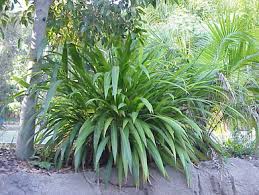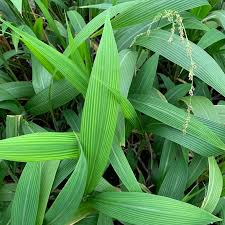Palm Grass, scientifically known as Setaria palmifolia, is a fascinating grass plant that stands out for its unique characteristics and diverse uses. This plant, with its long leaves resembling palm fronds, holds a special place in various cultures and ecosystems.
Found in tropical and subtropical regions, Palm Grass is easily identifiable by its tall stems and wide leaves that can reach up to 2 meters in length. Its scientific name, Setaria palmifolia, is derived from the genus “Setaria,” which includes several species of grasses, and the term “palmifolia,” which means “palm-like leaves.”
One of the remarkable features of Palm Grass is its adaptability. It can thrive in a range of environments, from open fields to forests and even disturbed areas. This adaptability makes it an important component of many ecosystems, providing shelter and sustenance to various forms of wildlife.
In addition to its ecological significance, Palm Grass also has cultural value. In some regions, its leaves are used for weaving mats, baskets, and other handicrafts. The leaves are carefully dried, dyed, and woven into intricate patterns that reflect the rich heritage of the communities using them.
Furthermore, Palm Grass has been recognized for its potential as a sustainable resource. Some studies have shown that it can be used for erosion control, helping to stabilize soil in areas prone to landslides. Additionally, its leaves have been explored for their potential as a renewable material in paper production.
As an ornamental plant, Palm Grass has gained popularity in landscaping due to its striking appearance. It can be grown as a focal point in gardens or used to add a touch of the exotic to outdoor spaces. Its towering stems and palm-like leaves create a tropical ambiance that appeals to many garden enthusiasts.
In addition, Palm Grass (Setaria palmifolia) is a versatile and intriguing plant with a wide range of applications. From its role in ecosystems to its cultural significance and potential uses in various industries, this plant exemplifies nature’s ability to provide resources and inspiration to humans. Its distinctive appearance and adaptability make it a plant worth appreciating and conserving for generations to come.
Read Also: Causes of Diseases in Farm Animals and How to Prevent Disease OutBreak
Growing and Care Guide of Palm Grass

Growing and caring for Palm Grass (Setaria palmifolia) can be a rewarding experience. Whether you’re interested in its unique appearance, its cultural significance, or its potential uses, following these guidelines will help you cultivate a healthy and thriving Palm Grass plant:
1. Choosing a Suitable Location: Select a location that receives partial to full sunlight. Palm Grass can tolerate a range of soil types but prefers well-draining soil. Make sure the area you choose has enough space for the plant to grow tall and spread its leaves.
2. Planting: Plant Palm Grass seeds or young plants in the spring or early summer, when the weather is warmer. Sow the seeds at a depth of about 1/4 inch in the soil and water lightly. Space the seeds or plants according to the desired density, keeping in mind that Palm Grass can spread.
3 Watering: Keep the soil consistently moist, especially during the plant’s early growth stages. However, avoid overwatering, as Palm Grass doesn’t tolerate waterlogged soil. Once established, the plant becomes more drought-resistant and requires less frequent watering.
4. Fertilizing: Fertilize Palm Grass with a balanced, slow-release fertilizer in the spring and summer. This will provide the necessary nutrients for healthy growth and vibrant foliage. Follow the manufacturer’s instructions for application rates.
5. Pruning and Maintenance: While Palm Grass doesn’t require extensive pruning, you can trim any dead or damaged leaves to maintain its appearance. Additionally, if the plant becomes too large for the space, you can thin out the clumps by removing excess plants.
6. Mulching: Applying a layer of mulch around the base of the plant can help retain moisture, suppress weeds, and protect the roots during extreme temperatures. Organic mulches like straw or wood chips work well.
7. Pest and Disease Control: Palm Grass is generally resistant to pests and diseases. However, keep an eye out for any signs of issues such as aphids or fungal infections. If needed, use appropriate organic or chemical treatments to address these problems.
8. Propagation: You can propagate Palm Grass by dividing mature clumps in the spring. Gently dig up the clump, separate the individual plants, and replant them in desired areas.
Remember that Palm Grass can spread, so be mindful of its growth habits and provide adequate space. By following these guidelines and adjusting them based on your specific growing conditions, you can enjoy the beauty and versatility of Palm Grass in your garden or outdoor space.
Benefits and Uses of Palm Grass

Palm Grass (Setaria palmifolia) offers a range of benefits and uses, from its ecological contributions to its cultural significance and potential applications:
Ecological Benefits
1. Soil Stabilization: Palm Grass can help prevent soil erosion due to its extensive root system and dense growth, making it useful for stabilizing soil on slopes and preventing landslides.
2. Wildlife Habitat: The plant’s thick foliage provides shelter and nesting sites for various wildlife, contributing to biodiversity in ecosystems.
3. Carbon Sequestration: Like other plants, Palm Grass plays a role in capturing carbon dioxide from the atmosphere, helping mitigate the effects of climate change.
Cultural Significance
1. Traditional Crafts: The leaves of Palm Grass are used in many cultures for weaving mats, baskets, hats, and other handicrafts. These traditional crafts hold cultural and artistic value and are often passed down through generations.
2. Symbolism: In some cultures, Palm Grass holds symbolic meanings, representing resilience, adaptability, and the connection between humans and nature.
Landscape Ornamentation
1. Garden Design: Palm Grass is used in landscaping to create tropical-themed gardens or as a focal point due to its unique appearance and towering growth.
2. Aesthetic Appeal: The plant’s palm-like leaves and graceful form add an exotic touch to outdoor spaces, enhancing their aesthetic appeal.
Potential Industrial Uses
1. Erosion Control: As a plant with a strong root system, Palm Grass is employed in erosion control measures to stabilize soil in areas prone to erosion and landslides.
2. Papermaking: The leaves of Palm Grass can be explored for their potential in paper production, offering a sustainable alternative to traditional paper sources.
Educational and Research Purposes
1. Botanical Studies: Palm Grass serves as a subject for botanical research and educational purposes, contributing to the understanding of plant adaptations and ecological roles.
2. Biodiversity: By providing habitat and sustenance for various wildlife, Palm Grass contributes to the diversity of species within an ecosystem.
Potential Economic Opportunities
1. Handicraft Industry: The traditional crafts created from Palm Grass leaves can support local economies and provide income for artisans.
2. Sustainable Materials: The plant’s leaves, if successfully utilized in papermaking or other industries, could offer a renewable and environmentally friendly material source.
Overall, Palm Grass offers a valuable blend of ecological, cultural, and economic benefits. Its ability to thrive in diverse environments, its significance in traditional practices, and its potential in various industries make it a versatile and meaningful plant. Whether it’s enhancing landscapes, preserving cultural heritage, or contributing to sustainable practices, Palm Grass demonstrates the interconnectedness of nature and human activities.
Read Also: Effect of Tropical Climate on Animal Parasites, Vectors and Diseases
Where to Find Palm Grass near Me/You
Palm Grass (Setaria palmifolia) can be found in various regions, primarily in tropical and subtropical areas. If you’re interested in locating Palm Grass, here are some places where you might come across it:
1. Botanical Gardens: Many botanical gardens, especially those with tropical or exotic plant collections, may have Palm Grass on display. Visiting a botanical garden can give you the opportunity to see the plant up close and learn more about its growth habits and care requirements.
2. Nurseries and Garden Centers: Nurseries and garden centers that specialize in tropical plants or landscaping materials might have Palm Grass available for purchase. If the plant is suitable for your climate, you could consider adding it to your garden or outdoor space.
3. Natural Habitats: In regions where Palm Grass is native or naturalized, you might find it growing in its natural habitat. Look for it in open fields, disturbed areas, along roadsides, and even near forest edges. Keep in mind that you should always respect local regulations and guidelines when exploring natural areas.
4. Local Plant Sales and Exchanges: Community events, plant sales, and gardening clubs could be sources of Palm Grass. Check out local advertisements, gardening forums, or social media groups where fellow gardening enthusiasts may offer or exchange plants.
5. Online Plant Retailers: If you’re unable to find Palm Grass locally, consider looking for reputable online plant retailers that offer a variety of plants. Ensure you choose a source that provides healthy and well-cared-for plants.
6. Horticultural Shows and Exhibitions: Events focused on horticulture, gardening, and landscaping might showcase unique and exotic plants like Palm Grass. Attending such shows could give you the chance to see and even acquire Palm Grass.
Before acquiring Palm Grass, it’s important to consider your climate and growing conditions. While Palm Grass is adaptable, it may not thrive in all environments. Make sure to research its suitability for your region and understand its care requirements before introducing it to your garden or collection.
Read Also: What is a Hydrocarbon Fuel?

Very interesting
Thank you so much and we are glad that you find our article very helpful